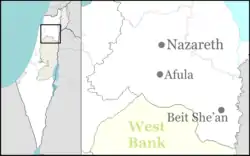Merhavia (moshav)
Merhavia (Hebrew: מֶרְחַבְיָה, lit. "Space of God") a moshav in northern Israel. It falls under the jurisdiction of Jezreel Valley Regional Council and in 2019 had a population of 662.[1] Founded in 1911, it was the first modern Jewish settlement in the Jezreel Valley.
Merhavia
מֶרְחַבְיָה | |
|---|---|
 | |
 Merhavia | |
| Coordinates: 32°36′17″N 35°18′29″E | |
| Country | Israel |
| District | Northern |
| Council | Jezreel Valley |
| Affiliation | Moshavim Movement |
| Founded | 1911 |
| Founded by | Kvutzat Kibush members and Second Aliyah immigrants |
| Population (2019)[1] | 662 |
| Website | www.merhavia.co.il |
Etymology
The name Merhavia is derived from the Book of Psalms 118:5.
Out of my straits I called upon the LORD; He answered me with great enlargement.
In the metaphorical sense: "God set me free" - the experience of the Jews immigrating to the Land of Israel and achieving a new homeland without the straits of persecution.
History
Co-operative
The village was established as the Co-operative in Merhavia, a co-operative farm, at the beginning of 1911, based on the ideas of Franz Oppenheimer.[2] The founders had arrived in the area in 1910 and consisted of members of Kvutzat Kibush and workers of the Second Aliyah. It was supposed to operate as a co-operative farm with differential wages, and was founded with the assistance of Arthur Ruppin, Yehoshua Hankin, the Anglo-Palestine Bank and Eliyahu Blumenfeld. Alexander Baerwald designed and built the first solid buildings and the road net with a central square in 1915.[3]
Moshav
In 1922 it was converted to a moshav ovdim after being joined by Polish-Jewish immigrants and residents of Tel Aviv who wanted to work in agriculture. According to a census conducted in the same year by the British Mandate authorities, the settlement had a population of 135 Jews.[4]
In 1929 a kibbutz, also by the name of Merhavia, was established next to the moshav.
Gallery
 Merhavia founders 1910
Merhavia founders 1910 Merhavia first building 1911
Merhavia first building 1911 Merhavia members of Hashomer 1915
Merhavia members of Hashomer 1915 Merhavia residents 1920
Merhavia residents 1920 Merhavia 1921
Merhavia 1921 Merhavia 1929
Merhavia 1929 Merhavia 1941
Merhavia 1941 Moshav Merhavia 1947
Moshav Merhavia 1947
Notable residents
- Henry Einspruch (1892–1977), a Galician-born Jew who converted to Lutheranism, becoming a Messianic missionary affiliated with the Hebrew Christian movement, best known for translating the Christian New Testament into Yiddish.
References
- "Population in the Localities 2019" (XLS). Israel Central Bureau of Statistics. Retrieved 16 August 2020.
- Co-operation in Palestine New York Times, 17 March 1914
- Myra Warhaftig (in German) (Hebrew: מירה ווארהפטיג), "Alex Baerwald", in: id., Sie legten den Grundstein. Leben und Wirken deutschsprachiger jüdischer Architekten in Palästina 1918-1948, Berlin and Tübingen: Wasmuth, 1996, pp. 34-41, here p. 35. ISBN 3-8030-0171-4